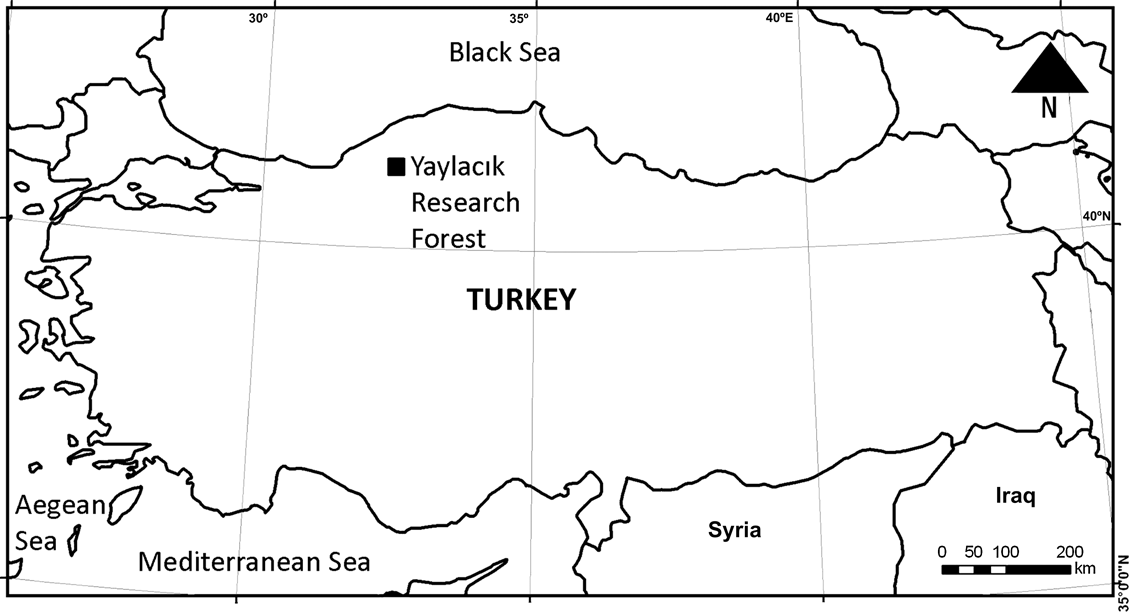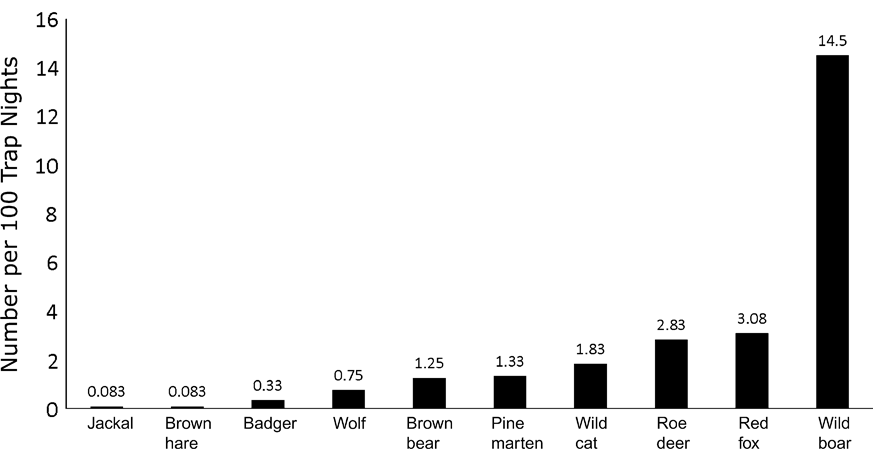Large mammals are often nocturnal and elusive, typically range widely, and occur infrequently over large parts of their distribution ranges (Sunquist & Sunquist, Reference Sunquist and Sunquist2002; Sanderson, Reference Sanderson2004). Accurate methods exist to monitor such species but they require extensive fieldwork, have high costs (Linnell et al., Reference Linnell, Swenson, Landa and Kvam1998) and need trained personnel. The availability of camera traps, however, now facilitates such monitoring under most environmental conditions (Holden et al., Reference Holden, Yanuar and Martyr2003; Silveira et al., Reference Silveira, Jàcomo and Diniz-Filho2003).
Several large mammal species that are ecologically, economically and scientifically important occur in Turkey but their distributions are only vaguely described (Turan, Reference Turan1984; Demirsoy, Reference Demİrsoy1996) and systematic field surveys and monitoring are practically non-existent for most of these species (Can & Togan, Reference Can and Togan2004). The objectives of the study described here were to compare local information on large mammals to information gathered from ground and camera trap surveys and to provide baseline data for future conservation research.
The study was conducted in the 50 km2 Yaylacık Research Forest, a relatively well protected area within the c. 750 km2 Yenice Forest in north-west Turkey (Fig. 1), a global forest hotspot (Lise, Reference Lİse2005) and one of the largest intact regions for mammal fauna globally (Morrison et al., Reference Morrison, Sechrest, Dinerstein, Wilcove and Lamoreux2007). The altitude of Yenice Forest is 100–2,000 m, it receives an average annual rainfall of 1,200 mm, mean annual temperature is 8.8°C and mean summer and winter temperatures are 30 and 1°C, respectively. Most of the rainfall occurs during spring and the average number of days with snow is 25. Tree species in Yenice Forest are beech Fagus orientalis, European hornbeam Carpinus betulus, Turkey oak Quercus cerris, Istıranca oak Q. hartwissiana, oak wood Q. petraea, Balkan maple Acer hyrcanum, Norway maple A. platanoides, common ash Fraxinus excelsior, yew Taxus baccata, Caucasian fir Abies nordmanniana and Scots pine Pinus sylvestris.

Fig. 1 Location of Yaylacık Research Forest in north-west Turkey.
In December 2005, to gather information on the presence of mammals in Yenice Research Forest, we interviewed forestry service personnel (n = 5) who had been working in the study area for 5–15 years and local people (n = 15) who had been working in logging activities for > 5 years, and we conducted ground surveys, on foot, to document tracks and signs of large mammal species. The interviews indicated that wolf Canis lupus, brown bear Ursus arctos, wild cat Felis silvestris, Eurasian lynx Lynx lynx, red fox Vulpes vulpes, Eurasian badger Meles meles, pine marten Martes martes, wild boar Sus scrofa and roe deer Capreolus capreolus are present in the study area. Ground surveys confirmed the presence of all of these species except lynx (which is reported from Yenice Forest; Turan, Reference Turan1984; Lise, Reference Lİse2005).
We conducted the camera trap survey during January–May 2006 using a combination of 12 CamTrakker (CamTrakker, Georgia, USA) and four DeerCam (DeerCam, Pak Falls, USA) passive infrared camera traps. The survey comprised five consecutive phases, each with 16 camera traps for 15 days in 8 km2 (Karanth & Nichols, Reference Karanth and Nichols2002; Karanth et al., Reference Karanth, Chundawat, Nichols and Kumar2004), thus covering 80% of the study area (40 km2). A total of 1,200 camera trap days of observation were made in total. The cameras were placed in each part of the study area to maximize the number of photographs taken, similar to other studies (Karanth & Nichols, Reference Karanth and Nichols2002; Holden et al., Reference Holden, Yanuar and Martyr2003; Wallace et al., Reference Wallace, Gomez, Ayala and Espinoza2003; Karanth et al., Reference Karanth, Chundawat, Nichols and Kumar2004; Maffei et al., Reference Maffei, Cuellar and Noss2004; Silver, Reference Silver2004; Wegge et al., Reference Wegge, Pokheral and Jnawali2004).
The camera trap survey produced a total of 402 photographs. No animals were registered in 63 (15.7%) photographs and 26 (6.5%) were of small mammals and birds. The remaining 313 photographs were of wolf, brown bear (Plate 1), wild cat, red fox, Eurasian badger, pine marten, wild boar and roe deer but not lynx. Although we did not locate signs of jackal Canis aureus or brown hare Lepus europaeus in our earlier ground survey they were documented by the camera trap survey, as the least trapped species (Fig. 2). The documentation of jackal and brown hare by the camera trap survey and the failure to document Eurasian lynx indicate that local information about the wildlife species in an area may not always be reliable and should be checked carefully with field research. This has important implications for Turkey, where most of the wildlife information used in management decisions comes from local people and authorities. In the absence of field studies, authorities depend on local information about the presence of mammals. This study demonstrates that, although such information is important, it cannot replace field surveys.

Fig. 2 Number of camera trap records (of a total of 313) per 100 trap nights, by species, in Yaylacık Research Forest.

Plate 1 Camera trap photographs of (a) wolf and (b) an adult male brown bear in Yaylacık Research Forest.
Our study also demonstrated that camera trapping has potential to gather reliable wildlife data with few personnel in protected areas in Turkey where there is minimum risk of theft and vandalism. The initial costs for conducting camera trap surveys is high because of the cost of the camera traps but once they are purchased they can be used for various research purposes. Information gathered from large-scale camera trap studies could provide the data required for management and conservation of mammals in Turkey.
Yenice Forest is a major logging area, generating revenue for the State and the local communities; 73,000 m3 of forest has been logged and an additional 24,000 m3 of forest was cut for fire wood during 1999–2005 (Lise, Reference Lİse2005). The forestry service is currently considering selective logging in Yaylacık Research Forest and the political pressure from local communities to utilize this forest as a logging area is increasing. Yenice Forest is one the largest intact forest habitats in Turkey and an important area for the long-term conservation of wolf, brown bear, wild cat and roe deer. However, currently only 1.6% (c. 12 km2 of 750 km2) of Yenice Forest is protected. We urge the Turkish Ministry of Environment and Forestry authorities and Turkish nature conservation organizations to direct their attention to Yenice Forest, which is important globally because of its intact mammal fauna. We have presented our results to the Turkish Ministry of Environment and Forestry authorities and to the Turkish Nature Association (Doğa Derneği) and WWF Turkey, and we have recently begun new research on the ecology of wolf, brown bear and wild cat in Yaylacık Research Forest.
Acknowledgements
We would like to thank Emin Nasuhoğlu, Murat Tuna, Koray Özer, Murat Altuntaş, Anıl Soyumert, Yıldıray Lise and Tuğba Can for their assistance, Dave Garshelis for his suggestions on methodology, and John Beecham for reviewing the manuscript. We thank Jon Swenson and an anonymous referee for constructive criticism. We are indebted to Metin Karadağ and his staff of Central Anatolia Forest Research Institute for providing accommodation and transportation in the field. We thank the General Directory of Nature Conservation and National Parks for the research permit for this study.
Biographical sketches
Özgün Emre Can's research interests are in large carnivore monitoring and conservation. He has worked with grey wolves in Minnesota, USA, with wolves, brown bears, striped hyenas and wild felids in Turkey, and is currently working as large mammal research and conservation coordinator at the Turkish Nature Association in Turkey. He is founder of Carnivore Initiative for Turkey, a member of the Society for Conservation Biology Europe Section Board of Directors, co-chair of the IUCN Bear Specialist Group South Asia Brown Bear Expert Team, and a member of the IUCN Wolf, Hyaena, Canid and Cat Specialist Groups. İnci̇ Togan carries out research on population biology and genetics. She has previously studied the brown trout of Turkey, and is currently studying the evolutionary history of human populations, domestic sheep and dogs in Anatolia. Through these studies she is hoping to find a strategy to prioritize the Anatolian sheep breeds for conservation.







